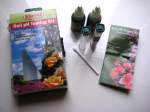Home › Plant guides › Climbers for sandy soil
Home › Garden soil › Climbers for sandy soil
The Best Climbers For Sandy Soil
The majority of climbers prefer to grow in deep, fertile, moist soil which is a problem if you are gardening on sand which is typically rather dry and low in nutrients.
However, some climbing plants are rather more tolerant of these soil conditions than others and I've chosen my favourites from among these.
Despite this I would always carry out a little soil improvement by mixing plenty of well rotted organic material (good garden compost is ideal) into the planting hole and giving a good deep organic mulch each spring.
This will boost soil fertility and increase moisture retention. It isn't a great deal of trouble and will greatly increase the chances of success.
It is also a good idea to water regularly in the first couple of seasons until the plants become well established.
My Five Favourite Climbers for Sandy Soil
Campsis x tagliabuana 'Madame Galen' (Trumpet Vine, Trumpet Creeper)
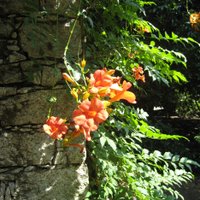
- Form:
- climber
- Foliage:
- deciduous
- Hardiness:
- UK - hardy; USDA zones 5 to 9
- Soil:
- any moist but well drained soil
- Situation:
- sunny sheltered site
- Height:
- 10m (33ft)
- Awards:
- RHS AGM
Reasons to grow: This strikingly exotic looking climber for sandy soil has long pinnate leaves up to 12in (30cm) and bears copious hanging clusters of trumpet shaped orangey-red flowers from late summer into autumn.
The whole effect is positively tropical!
Although it is tougher than it looks, it may need some winter protection for the first couple of years and is best grown in a sheltered spot against a warm sunny wall.
Clematis 'Niobe'
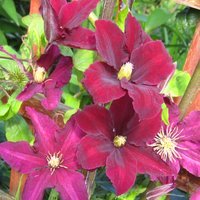
- Form:
- twining climber
- Foliage:
- deciduous
- Hardiness:
- UK - hardy; USDA zones 4 to 9
- Soil:
- humus-rich well-drained soil
- Situation:
- sun to partial shade
- Height:
- 2-3m (6-10ft)
- Awards:
- RHS AGM
Reasons to grow: The profusion of large, wine-red flowers with contrasting golden stamens are produced throughout summer making this a real showstopper.
My photo doesn't really do it justice. The blooms have a velvety texture and the colour glows with a rich, jewel-like quality.
Although it will grow equally well in full sun or partial shade, I have found the colour fades more in the sun.
It grows to a manageable height and I suspect it might be a good candidate for a large patio planter.
As with all clematis, add lots of organic material at planting time and keep the roots cool with a layer of stones. A good organic spring mulch and a feed will also be appreciated.
Also consider: There are thousands to choose from so it is possible to have a clematis in flower at all times of the year. Most of them will grow in sandy soil provided you are prepared to do some initial soil preparation and give an annual mulch and feed.
Clematis flammula, the delightfully named Virgin's Bower, would be a good candidate for very poor dry soils. Growing to a height of up to 20 feet (6m) it bears masses of sweetly scented white flowers in summer. In mild winters it is semi-evergreen.
Clematis montana is another vigorous climber (up to 30ft or 9m) that is pretty hard to kill but it is a bit of a beast being both very large and very unruly and I think it looks best scrambling through a largish tree. There are both pink and white varieties, some of them nicely scented. 'Tetrarose' is good deep pink with bronze tinted foliage and a good scent.
Hedera helix 'Caecilia' (Common Ivy, English Ivy)
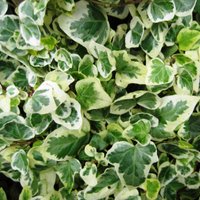
- Form:
- self clinging climber
- Foliage:
- evergreen
- Hardiness:
- UK - hardy; USDA zones 5 to 10
- Soil:
- prefers humus-rich, well-drained soil, preferably alkaline, but not that fussy.
- Situation:
- sun to shade
- Height:
- 1-1.5m (3-6ft)
- Awards:
- RHS AGM
Reasons to grow: Ivies are such useful plants with a multitude of uses. I was given this one as a houseplant and liberated it into the garden where it grows out of gravel and up a low stone wall.
The small, lobed, light green leaves are edged and blotched with a creamy white and do a brilliant job of brightening up a rather dull corner.
The whole plant is quite compact and would also look good trained on to a topiary frame or used as ground cover.
Also consider: There are hundreds of varieties to choose from with a range of leaf shapes and colours.
My favourites include 'Parsley Crested', which has green leaves with crinkly margins creating a fascinating textural quality, 'Buttercup' with bright golden yellow leaves, and 'Atropurpurea' which is a rich, deep purple and can reach a height of around 8m (26ft).
Humulus lupulus 'Aureus' (Golden Hop)
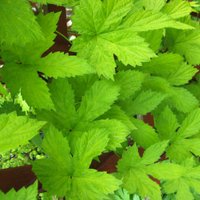
- Form:
- twining climber
- Foliage:
- deciduous
- Hardiness:
- UK - hardy; USDA zones 4 to 8
- Soil:
- fairly rich, moist but well-drained soil
- Situation:
- sun or partial shade
- Height:
- 6m (20ft)
- Awards:
- RHS AGM
Reasons to grow: This exuberant climber produces masses of bright golden green, deeply lobed leaves, up to 6 inches (15cm) in length, and fascinating drooping cones of flowers.
It is very vigorous, growing to a height of around 20 feet (6m) each year, and I think it looks at its best when given the freedom to romp away over structures or garden buildings. In my own garden I grow it over a large, very sturdy, trellis arch.
The impressive mound of golden foliage is the perfect backdrop for plants with contrasting foliage or flowers. It is especially good with deep blue, purple and rich red and looks great with Ceanothus and the jewel-like blooms of clematis.
Although it likes well-drained soil, it does appreciate a good helping of compost or well rotted manure mixed into the planting hole, and an annual mulch of the same. At the end of the season it will die down and the old stems can be cut back to near ground level.
Caution: The golden hop is covered in fine hairs which can be irritating to sensitive skin so don't plant it where you are likely to brush against it in passing, and wear long sleeves and gloves when you handle it.
Trachelospermum 'Tricolor' (Variegated Star Jasmine)
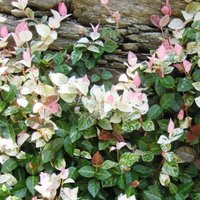
- Form:
- twining climber
- Foliage:
- evergreen
- Hardiness:
- UK - frost hardy; USDA zones 7 to 10
- Soil:
- moist but well-drained soil
- Situation:
- sun or light shade
- Height:
- 2-4m (6.5-13ft)
Reasons to grow: I first saw this beautiful variegated Star Jasmine growing up a sunny stone wall in the grounds of the Villa Taranto on Lake Maggiore, Italy, and was instantly captivated by the beautiful foliage.
The new leaves emerge in delicate shades of creamy white and soft pink before turning green mottled with cream.
I should say that this form does not flower well and is grown mainly for its foliage.
It is relatively slow growing and can take a year or two to become established. It is slightly tender and in colder areas it would benefit from the protection of a south facing wall. Once it matures though, it is quite tough and also reasonably drought tolerant.
In the gardens of the Villa Taranto this plant was labelled as Trachelospermum jasminoides 'Tricolor' but I have since discovered that there is some confusion as to whether this is correct or if it is a form of T. asiaticum.
Also consider: T. jasminoides for a larger, more vigorous climber, with jasmine scented white flowers set against dark green leaves or T. asiaticum for a more hardy species with creamy flowers.
Need More Information?
More plants that grow in sandy conditions can be found at perennials for sandy soil.
Not looking for plants for sandy soil? Head over to plant guides for links to all the 'plants for places' pages on this site.
You can find information and advice about garden soil, including links to other soil-related pages, at garden soil.
Home › Plant guides › Climbers for sandy soil
Home › Garden soil › Climbers for sandy soil
